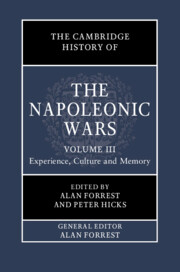Book contents
- The Cambridge History of the Napoleonic Wars
- The Cambridge History of the Napoleonic Wars
- The Cambridge History of the Napoleonic Wars
- Copyright page
- Contents
- Figures
- Maps
- Contributors to Volume III
- Introduction to Volume III
- Part I The Experience of War
- Part II The Experience of Imperial Rule
- Part III War, Culture and Memory
- 12 Memoirs and the Communication of Memory
- 13 Festivals, Ceremonies and Public Commemorations
- 14 The Portrayal of Heroism
- 15 The Fine Arts and the Napoleonic Wars
- 16 Poets and Novelists: Writing the Memory of War
- 17 Political Keyboard Music in Revolutionary and Napoleonic France: ‘The Battle’
- 18 The Napoleonic Wars in Caricature
- 19 The Napoleonic Wars in European Cinema
- 20 Nostalgia, or a Ruin with a View
- Part IV The Aftermath and Legacy of the Wars
- Bibliographic Essays
- Index
14 - The Portrayal of Heroism
from Part III - War, Culture and Memory
Published online by Cambridge University Press: 05 August 2022
- The Cambridge History of the Napoleonic Wars
- The Cambridge History of the Napoleonic Wars
- The Cambridge History of the Napoleonic Wars
- Copyright page
- Contents
- Figures
- Maps
- Contributors to Volume III
- Introduction to Volume III
- Part I The Experience of War
- Part II The Experience of Imperial Rule
- Part III War, Culture and Memory
- 12 Memoirs and the Communication of Memory
- 13 Festivals, Ceremonies and Public Commemorations
- 14 The Portrayal of Heroism
- 15 The Fine Arts and the Napoleonic Wars
- 16 Poets and Novelists: Writing the Memory of War
- 17 Political Keyboard Music in Revolutionary and Napoleonic France: ‘The Battle’
- 18 The Napoleonic Wars in Caricature
- 19 The Napoleonic Wars in European Cinema
- 20 Nostalgia, or a Ruin with a View
- Part IV The Aftermath and Legacy of the Wars
- Bibliographic Essays
- Index
Summary
Heroism is a category that seems integral to our understanding of the Revolutionary and Napoleonic Wars, as indeed it was for those who participated in them, whether on the battlefield or as more distant denizens of what Mary Favret has termed ‘war-time’, the unique temporal sensorium that connected far-flung individuals to a broader concept of total war.1 Central to this category was, of course, the figure of Napoleon himself. The Emperor was, as Thomas Carlyle memorably dubbed him in his May 1840 lectures, published a year later as On Heroes, Hero-Worship, and the Heroic in History, ‘our last Great Man!’2 Yet despite his paradigmatic status, for Carlyle Napoleon’s undoing could be found in his precipitous shift away from Enlightened rationalism. Grounding his power in charismatic sincerity combined with numinous sensory overload, the Emperor increasingly embraced spectacular effects, making them part of his personal mythology; ‘Napoleon has words in him which are like Austerlitz Battles’, wrote Carlyle. The end result was, for Carlyle, a free-floating approach to truth, and the promulgation of a belief in what might now be termed ‘fake news’. This myth-making process could be discerned most explicitly in the diverse visual culture of the Napoleonic period that produced and circulated concepts of heroism. Whether addressed by way of overtly propagandistic images that sought to reframe, divert, or amplify authentic military testimony, or through attempts to profit from war in works that appealed directly to the whims of the market, heroism was a highly emotive yet fundamentally unstable category. Although his own writing was itself deeply imagistic, Carlyle did not make this point overtly.
- Type
- Chapter
- Information
- The Cambridge History of the Napoleonic Wars , pp. 279 - 301Publisher: Cambridge University PressPrint publication year: 2022



